By Dave McCracken
“A Preliminary Evaluation”
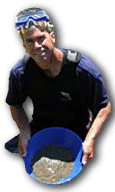
Note: This is the non-proprietary portion of an initial report from a preliminary evaluation of a potential suction dredging project in Northern Sumatra (Indonesia). The opportunity to do something with this prospect still exists. The evaluation was done in April of 2005. The gold values have been modified to reflect gold prices in mid 2010.
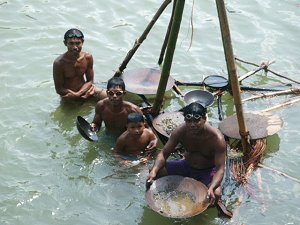 This project is located on the island of Sumatra in Indonesia, directly to the west of Singapore. I arrived there by flying to Singapore, and then by taking a 1-hour boat-ride to Batam Island (Indonesia). From there, I caught a flight to Padang. Padang is the capital of Western Sumatra. At the time, this was a better connection than trying to fly directly to Padang from Singapore.
This project is located on the island of Sumatra in Indonesia, directly to the west of Singapore. I arrived there by flying to Singapore, and then by taking a 1-hour boat-ride to Batam Island (Indonesia). From there, I caught a flight to Padang. Padang is the capital of Western Sumatra. At the time, this was a better connection than trying to fly directly to Padang from Singapore.
A representative from the company that hired me was waiting at the airport in Padang. We then drove 2 hours north to a place called Bukittinggi where they have a home and office. The company manager was already up at the base camp. They had arranged for a driver to bring me up there on the following day.
Bukittinggi is a lot like the towns we have in the West. In fact, as shown in the following video segment, if it were not for the different language on the signs, this city could easily be mistaken for almost any town in America.
The roads and other infrastructure in western Sumatra are pretty darn good. The people seem nice. Things are relatively inexpensive. English is not spoken very much, but the people are forgiving and do their best to help figure things out.
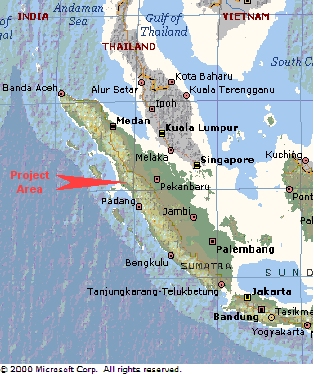
The location of this project was situated about a third of the way north to Medan (from Padang). Medan is the capital of northern Sumatra. It is the second-largest city in Indonesia.
There is a good road that leads to the project-area and follows alongside the river. So accessibility to the river is generally very good.The following video sequence was taken as we were driving north to the project site. You will notice that they drive on the left side of the road in Sumatra:
The river is about the same size as the Klamath River in northern California, but will reduce in size as the dry season progresses. The river is flowing with clear water. Although, visibility can be lost during the afternoons if local miners are sluicing upstream (more on this follows).
During my visit, the river was ideal to sample using a 5-inch dredge. Productiondredging or volume sampling could easily be accomplished using 8-inch dredges or larger.
There are regular access-points to the river from the road along the river. And there are small villages along the road where local miners and other laborers or helpers and various services and supplies are available at relative low cost. Power and land-line telephone appear to be present along the entire road.
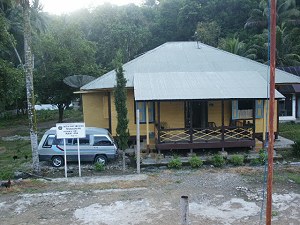 As the speedometer was not working on the vehicle that we were using, I did not get an exact mileage-count on the amount of river that is available to this project. But it is safe to say that there is at least a 20-mile stretch of readily-accessible gold-bearing river where local small-scale miners are actively recovering gold.
As the speedometer was not working on the vehicle that we were using, I did not get an exact mileage-count on the amount of river that is available to this project. But it is safe to say that there is at least a 20-mile stretch of readily-accessible gold-bearing river where local small-scale miners are actively recovering gold.
Our client has hired a local administrator from the main town along the river. The local administrator has arranged permission to temporarily set up a base camp in a vacant house which is owned by the government. The house and property are ideal for a base until other arrangements can be made. There is a small store and restaurant on the property. There is some storage. The house has several comfortable bedrooms, electric power, bathrooms and a dining room. The local cook does a good job. It is a comfortable setting. The base camp contains all of the basic structure needed to support a gold dredging project.

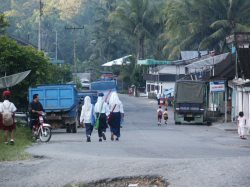
Local communities are generally Muslim. Friendly. I did not detect a single bad feeling from anyone during the entire time that I was on the river. There was actually a lot of friendly interest, because white folks are not often seen in these parts.Here is a video sequence I captured in a nearby, larger-sized community:
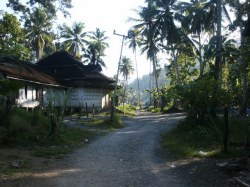
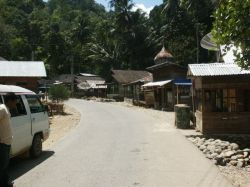
It will be important to be mindful of possible cultural differences, though. Any westerners brought in to assist with this project will need to be careful to not disrupt local tranquility. Hiring a good, local administrator will be important so that we can facilitate communication in a positive way. Interpreters will be important in key places where local labor is being directed or managed by outsiders.
Our client has done a great job putting the basic support structure in place.
My client is a mining engineer from Europe who settled in Sumatra and has devoted the past 20+ years locating and developing mineral opportunities there. We have worked together on several projects in the past, two which were located in Borneo (Indonesia), another in Cambodia.. He has been involved with numerous different types of projects which I will not go into here. He is very experienced at working in Sumatra. He understands the culture(s) and he speaks the languages.
One interesting thing at the moment is that my client has also recently located an important iron-ore discovery in the same area. He is in the process of quantifying the deposit with a company of consulting-geologists that are based out of Jakarta. I was fortunate to meet the Director of this consulting-group during my visit. They are doing exactly what we have in mind: They are mapping and certifying reserves of proven mineral deposits in a manner that the final documentation can be placed on a bankable balance sheet.
While pursuing the iron-ore program, my client observed that the locals along the river were actively sluicing for gold. So he asked me to come over for a look. This was my first trip to this particular area of Sumatra.
Local Mining Activity
I observed three different methods of active gold mining occurring along the river:
1. Panning gravels from the gravel bars alongside the river.
2. High-banking the river gravels from the gravel bars in and alongside the river (description follows).
3. Panning river gravels that are being extracted from the bottom of the active river by divers (referred to in this report as “dive-miners”).
I could also see the telltale signs of past high-banking activity in placer diggings alongside the river not far downstream of the main town. My client’s local administrator told me that he believes the richest area along the river is upstream of the main town. That portion of the river extends away from the main road. I did not get a look at it on this first visit. He says that gold nuggets as big as several kilograms in size have been found up there. But, because local miners have no means to deal with the larger boulders, they mostly do their mining further downriver where we saw them operating.
I observed a of dozen or so active panning operations along the edges of the river where locals are panning surface gravels.
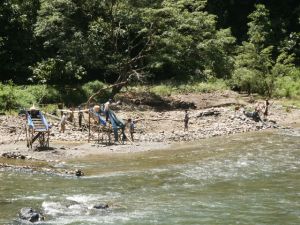
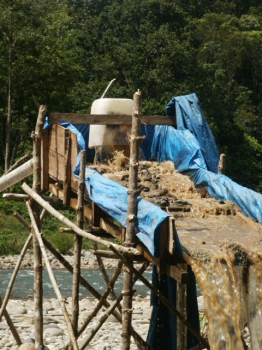
I also observed around a dozen active high-banking projects. Most of these projects are being accomplished with the use of two motorized pumps. One pump is used to suck ground-water out of active excavations, lowering water levels so that workers can excavate bottom gravels. The other pump is used to create suction through a 4-inch PVC (plastic) suction pipe. Material is washed down to the intake-pipe at the bottom of the excavation, sucked up and directed through a primitive (very) sluice box that rests on stilts out of the water. These pumps allow gravel-material up to (approximately) 3-inches in size to be passed through the pump.
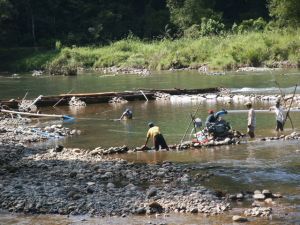
Local miners are building wing dams, which allow them access to gravel out in the active waterway.
Local miners are actively wing-damming (building a barrier to direct the water around an open excavation) around shallow places in the active river where they want to mine. They then pump the excess water out of open excavations, while processing gravels out of them. Whole teams of local miners (as many as 20+ people) are working together in these high-banking projects.
The downside is that tailings-water from some of the high-banking projects is allowed to flow back into the active waterway. This eliminates water visibility for some distance downstream. Depending upon where you go, underwater visibility can be lost by mid-afternoon. But even in those places, there remains an opportunity to do underwater work starting early in the morning – or possibly doing night operations with the use of flood lights from the surface. Or by dredging upstream from active high-banking operations.
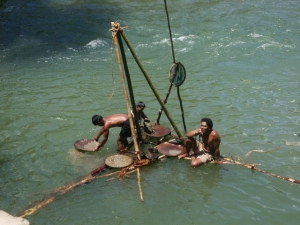
Dive-miners on a floating platform
I also observed some mining activity where local divers are bringing up gravel from the bottom of the river and panning it at the surface. These divers do not have access to the right kind of air compressors for underwater breathing, so they are free-diving (holding their breath while diving down under the water) to excavate bottom-gravels from the active river. Because of this, their production-capability is severely limited. All of the dive-miners I observed were bringing gravels to the surface with the use of metal cooking pots.
As the purpose of my first visit to this river was to confirm the existence of potentially-viable gold deposits within the active river, these dive-miners are the ones we decided to spend some time with.
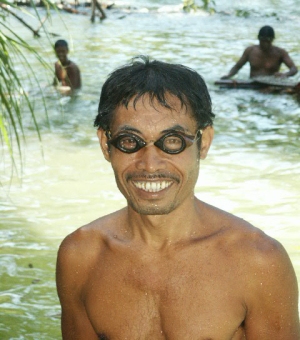 Local dive-miners carve their diving goggles out of hardwood or bone from some kind of big animal. Lenses are made from glass that is glued onto the goggles with epoxy. The goggles are attached to a diver’s face with a strap cut out of a piece of tire-inner tube rubber. There is no face-seal, and there is no way to equalize pressures inside the goggles. This creates a natural limit to how deep dive-miners can go beneath the water’s surface.
Local dive-miners carve their diving goggles out of hardwood or bone from some kind of big animal. Lenses are made from glass that is glued onto the goggles with epoxy. The goggles are attached to a diver’s face with a strap cut out of a piece of tire-inner tube rubber. There is no face-seal, and there is no way to equalize pressures inside the goggles. This creates a natural limit to how deep dive-miners can go beneath the water’s surface.
Nevertheless, local dive-miners are diving down to around three meters and bringing up gravel. And the gravel contains a lot of gold in proportion to the volume of gravel that is being processed. The local gold-buyer told us that around 5 kilograms of gold are being bought every day from local miners along this river. The going price is around $44 per gram. If the gold-buyer is telling the truth, that amounts to around $220,000 in gold.
To put this in perspective, a 10-inch dredge in experienced hands, with some underwater visibility, should be able to process about as much volume as all of the mining activity combined that I observed along the river.
All of the local miners we spoke with agreed that the richest gold is located in the deeper-water areas of the river where they are not able to reach using their methods. While divers can get underwater, they do not have the technology to excavate the deeper-gravel deposits that exist down there. A person can only get so much accomplished using a cooking pot on a breath of air!
So unless they are lucky enough to find rich deposits in the shallow spots along the edge of the river, existing technology available to local miners generally does not allow them access to the higher-grade areas located along the river-bottom. For the most part, local miners are working average gravels along the edges.
Confirmation
All of the images of the mining activity that were initially sent to me by my client showed high-banking activity that was taking place outside of the active river.
Sometimes, there can be high-grade deposits being mined alongside the river; but local conditions (deep gravel, dirty water, etc.) do not allow for a viable dredging opportunity within the active river. Therefore, the main purpose of my first visit to this area was to establish if there are high-grade gold deposits inside the active waterway, and to assesswhether or not we can perform a production dredging program there.
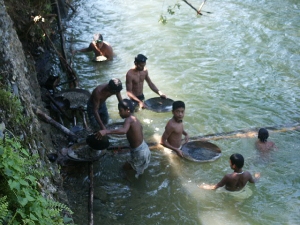
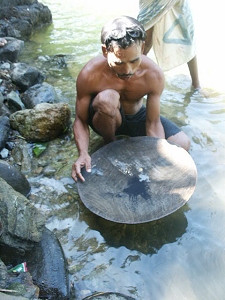
Approximately 5 miles downstream from the main town, we found a company of around ten local dive-miners who were swimming down to bring up gravel from an underwater excavation. We observed that they were recovering a substantial amount of gold in proportion to the small volume of gravel being processed. As this was an excavation project inside the active waterway, my client and I made a quick plan to complete our initial confirmation while working with this group of dive-miners.
After spending a little time getting to know these dive-miners, one of their leaders offered to take us on a short tour and show us some of the richer areas where they had done some dive-mining along the river. He showed us several places where he said their team-program had recovered as much as three ounces of gold per day at times. Each place he showed us was consistent with the types of areas where we find high-grade pay-streaks on the Klamath River in northern California.
According to our guide, the combinations of water-depth and/or gravel-depth usually prevent dive-miners from pursuing the richest deposits in the river.
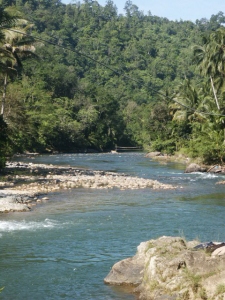
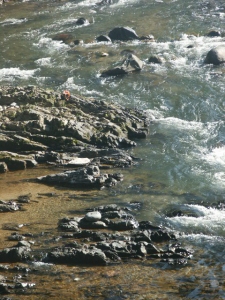
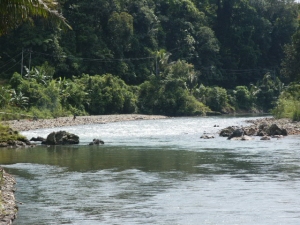
This river is very similar to the rivers that we dredge in California. There are regular directional changes, a steady drop, and fast-water areas in the river, which create the natural diversity required to form high-grade pay-streaks. There is plenty of bedrock showing and deep water pools.
Our guide told us that the river gravels pay in gold-values starting from around a foot below the surface, all the way to the bedrock. He said the richest gold is often on the bedrock, and sometimes they can see gold inside the cracks when they are able to get down that far. He said that 1 and 2-gram gold nuggets are not uncommon. He said the biggest nugget he personally found was 10-grams (32.1 grams to the troy ounce).
In anticipation of the eventual need, several years ago, I shipped a T-80 air compressor, a dive-regulator and the required air-fittings over to this client in Sumatra from California. He arranged to mount the compressor with a small Honda motor. We brought that diving gear along with us on this trip.
So after getting to know our guide on the river, we volunteered to use the compressor to help his company of dive-miners excavate gravels from the deepest part of their ongoing excavation. I offered to allow them to keep all the gold we found, as long as we could buy it from them at the going price. They readily agreed. The purpose of this was to allow me the opportunity to get a direct look at the streambed conditions from which we would recover the gold, and to allow me to measure the amount of gravel that we would process so we could place a relative value on the raw material.
It did not take long to get me into the water, where with the use of a cooking pot as a digging tool, I started filling a wash-bucket with gravel from the bottom of their ongoing excavation. Filling up buckets with material underwater is a pretty slow process. It required three gold-panners to keep up with my progress.
The existing excavation from this company of dive-miners was pretty substantial, considering that progress was being accomplished using cooking pots while free-diving down to around three meters of water. They had worked down a face of bedrock along the edge of the river to around 6 or 7 feet into a semi-hard-packed streambed material. They had not yet reached where the bedrock bottomed-out (where the highest-grade material should be located). Even so, I did see some gold flakes in the bedrock along the face that they are following.
According to the dive-miners, they have been working that specific excavation for 2 months, and had so far recovered around 2 kilograms of gold ($80,000.00). To put the size in perspective, we could open an excavation that size in about half a day using a 10-inch dredge. Opening an excavation is much slower than continuing one that is already opened up. Conservatively, the local dive-miners had recovered 2 kilograms of gold in about 25% of a day’s ongoing production using a 10-inch suction dredge.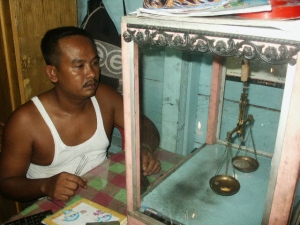
The local gold buyer weighed the gold recovered from our 20-bucket sample and offered to buy it for approximately $25.00 (US) in local currency based on the daily price of gold on April of 2005.
Since I was able to stay deep using the compressor, I extracted gravel from the bottom of the hole. I brought up 20 buckets of material, which were carefully panned by several helpers from the local mining team. In all, we recovered 1.1 grams (around $48.00) from my sample. This amounts to approximately $2.40 (US) per bucket at current gold prices. This was a typical medium-sized wash bucket. A single 5-inch dredge would excavate the volume of material contained in a wash-bucket in several seconds. A 10-inch dredge would scarf it up in the flash of an eye!
The thing that makes this so interesting is that the gravel I brought to the surface, for the most part, was material which had been sliding down into the bottom of the hole from the upper-side of the excavation. Although I did get some material that adjoined the bedrock on one side of the hole, I was forced mainly to extract gravel that was sliding down into the hole from further up in the excavation. The nature of scooping samples with a cooking pot underwater is that you take whatever you can get. Unlike dredging, you do not have an option to move top-material out of the way to get down to more productive stream layers located deeper in the river.
At the same time that I was taking samples from the deeper part of the excavation, the other dive-miners from the local company were bringing up samples from shallower streambed material. While I did not add it up, I did observe that their pans seemed to have just as much gold as we were getting from deeper in the hole. Most of the material I brought to the surface slid in from the shallower area where the other dive-miners were working.
While it still remains to be confirmed from a more organized sampling program using a suction dredge, this preliminary indication, along with the information given to us by these miners, indicates that the average gravels in this river almost certainly do contain commercial gold value.
More often, we are accustomed to finding that average river-bottom gravels carry non-commercial gold values, and that it is necessary to locate the high-grade gold deposits which usually form in the contact-zones between flood layers or on top of the bedrock. The existence of commercial gold-value in average gravels likely means that the pay-streaks will be even higher-grade.
We have confirmed that commercial gold deposits can potentially be dredged from this river. The next step is to follow up with a preliminary dredge sampling program.
Recommendations
First: I am suggesting to my client that he follow-up to see if exclusive commercial rights can be obtained for mining gold along this river. If so, I am advising him to arrange it as soon as possible. If the client is looking for a partner to develop the prospect, as long as the cost is reasonable, we can help arrange the financial resources to help pay for concession-rights.
Whether or not acquisition of exclusive rights (not excluding local mining activity) to develop the gold deposits along the river will affect the way we should proceed:
A. Quantification and marketing the proven reserves: If we can obtain the exclusive commercial rights, we should look hard at the concept of implementing a sampling program in concert with credible consulting-geologists to confirm and certify the existence of proven reserves. The purpose here would be to market the reserves to a larger public-traded mining company. In this event, we are prepared to help provide the funding and expertise to perform the sampling program. A good start would be to consider contracting with the same firm our client is using on the iron-ore project to perform the geological functions required to map and substantiate proven reserves.
B. Mining high-grade gold deposits: In the event that exclusive commercial rights on the river are not available, or a preliminary dredge-sampling survey convinces us that average reserves are not marketable, based upon what local miners are recovering from the river using primitive methods, it is a near certainty that money can be made using dredges to target high-grade gold deposits.
A preliminary dredge sampling program will be necessary whichever way we move forward with this project.
There would be several objectives in the preliminary dredge sampling program:
1. Determine if the average gold-values in the river will support a quantification program (outlined in A above) with the purpose of marketing proven reserves to a larger mining company.
2. Establish the value of high-grade deposits to get an idea how much money can be made from going right into commercial production.
3. Work out what recovery equipment will be needed to pursue either step A or B above.
4. Work out how we will harmonize a dredging program with local miners, general populations along the river, and others (government officials) who will take an interest in what we are doing.
It would be wise to allow no less than a month for the preliminary dredge sampling. To keep costs down until we confirm a commercial opportunity,if possible, I suggest we use the client’s existing structure as much as possible — meaning vehicles, local staff and the existing base camp.
To perform the preliminary sampling, we would need to hire several local dive-miners. I would like to choose them.
If possible, I would also like to hire an assistant/interpreter person who can stay with us throughout the project to help facilitate communication and coordination with locals. This might be someone that the existing geology-firm could provide. Having someone who is sincerely dedicated to projecting our intention and goodwill during the sampling project will go a long way to facilitate steady progress in the field.
Therefore, the next step is for us to find out:
A. Can we obtain exclusive commercial mining rights on the river? If so, at what cost?
B) Can we obtain permission to proceed with a suction dredge exploration program? If so, at what cost?
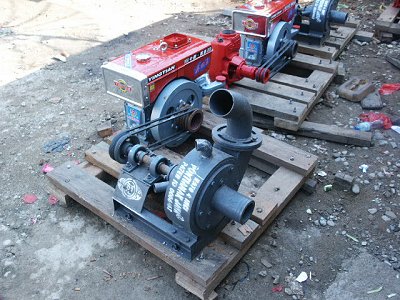 Pumping systems used to support local high-banking operations.
Pumping systems used to support local high-banking operations.
If gaining permission to use a suction dredge is going to delay the project, we also have the option of proceeding with a system like what the locals are using in their high-banking operations. Just by adding an air compressor and an extended suction hose, we can adapt a sluicing operation (like what locals are using) to an underwater dredging program. In this case, we should allow a week to fabricate an improved recovery system. If we go this way, with just a little instruction, we can hire locals to do all or most of the work. So, for the most part, this would just be another local mining operation.
Having said that, using a floating dredge would be much more efficient for moving the gear around to each place that we want to sample. A 5-inch suction dredge in experienced hands will also out-produce one of those sluicing outfits about ten times over! Still, if necessary, we could get the preliminary sampling job accomplished using (for the most part) local equipment.
Dave McCracken
Underwater Mining Specialist
- Here is where you can buy a sample of natural gold.
- Here is where you can buy Gold Prospecting Equipment & Supplies.
- More Gold Prospecting Adventures
- Books & Videos by this Author
- The Preliminary Evaluation
- Dredging for Gold
- Logistical Planning
- Schedule of Events





